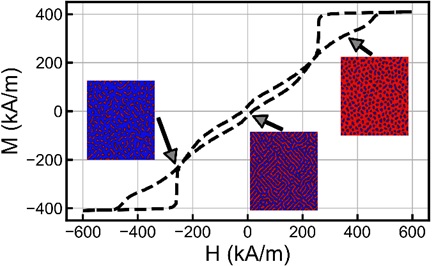BORIS – Micromagnetic, Spin Transport and Multiscale Atomistic Software for Modelling Magnetic Information Storage
DOI:
https://doi.org/10.59973/ipil.43Keywords:
BORIS; , Atomistic modelling of magnetic information storage;, Skyrmions; , Multi-GPU computations;Abstract
A brief review of BORIS is given here, together with a review of recent works using this software, including applications to modelling magnetic hard-disk-drive read heads, ultrafast magnetization processes, computation of thermodynamic equilibrium states using Monte Carlo algorithms, and modelling skyrmions as information carriers. BORIS is a state-of-the-art multi-physics and multi-scale research software designed to solve three-dimensional magnetization dynamics problems, coupled with a self-consistent charge and spin transport solver, heat flow solver with temperature-dependent material parameters, and elastodynamics solver including thermoelastic and magnetoelastic/magnetostriction effects, in arbitrary multi-layered structures and shapes. Both micromagnetic and atomistic models are implemented, also allowing multi-scale modelling where computational spaces may be configured with multiple simultaneous micromagnetic and atomistic discretization regions. The software allows multi-GPU computations on any number of GPUs in parallel, in order to accelerate simulations and allow for larger problem sizes compared to single-GPU computations – this is the first magnetization dynamics software to allow multi-GPU computations, enabling large problems encompassing billions of cells to be simulated with unprecedented performance.
References
S. Lepadatu, Boris computational spintronics — High performance multi-mesh magnetic and spin transport modelling software. J. Appl. Phys. 128, 243902 (2020). https://doi.org/10.1063/5.0024382 DOI: https://doi.org/10.1063/5.0024382
T.L. Gilbert, A Lagrangian formulation of the gyromagnetic equation of the magnetic field. Phys. Rev. 100, 1243 (1955).
D.A. Garanin, Fokker-Planck and Landau-Lifshitz-Bloch equations for classical ferromagnets. Phys. Rev. B 55, 3050 (1997). https://doi.org/10.1103/PhysRevB.55.3050 DOI: https://doi.org/10.1103/PhysRevB.55.3050
D.A. Garanin and O. Chubykalo-Fesenko, Thermal fluctuations and longitudinal relaxation of single-domain magnetic particles at elevated temperatures. Phys. Rev. B 70, 212409 (2004). https://doi.org/10.1103/PhysRevB.70.212409 DOI: https://doi.org/10.1103/PhysRevB.70.212409
R.F.L. Evans et al., Stochastic form of the Landau-Lifshitz-Bloch equation. Phys. Rev. B 85, 014433 (2012). https://doi.org/10.1103/PhysRevB.85.014433 DOI: https://doi.org/10.1103/PhysRevB.85.014433
S. Zhang and Z. Li, Roles of Nonequilibrium Conduction Electrons on the Magnetization Dynamics of Ferromagnets. Phys. Rev. Lett. 93, 127204 (2004). https://doi.org/10.1103/PhysRevLett.93.127204 DOI: https://doi.org/10.1103/PhysRevLett.93.127204
S. Lepadatu, Effect of inter-layer spin diffusion on skyrmion motion in magnetic multilayers. Scientific Reports 9, 9592 (2019). https://doi.org/10.1038/s41598-019-46091-1 DOI: https://doi.org/10.1038/s41598-019-46091-1
C.R. MacKinnon, S. Lepadatu, T. Mercer, and P.R. Bissell “Role of an additional interfacial spin-transfer torque for current-driven skyrmion dynamics in chiral magnetic layers” Physical Review B 102, 214408 (2020). https://doi.org/10.1103/PhysRevB.102.214408 DOI: https://doi.org/10.1103/PhysRevB.102.214408
M.I. Dyakonov and V.I. Perel, Possibility of orienting electron spins with current. JETP Lett. 13, 467-469 (1971).
J.C. Slonczewski, Current-driven excitation of magnetic multilayers. J. Magn. Magn. Mater. 159, L1–L7 (1996). https://doi.org/10.1016/0304-8853(96)00062-5 DOI: https://doi.org/10.1016/0304-8853(96)00062-5
S. Lepadatu, Unifed treatment of spin torques using a coupled magnetisation dynamics and three-dimensional spin current solver. Scientific Reports 7, 12937 (2017). https://doi.org/10.1038/s41598-017-13181-x DOI: https://doi.org/10.1038/s41598-017-13181-x
J.E. Hirsch, Spin Hall Effect. Phys. Rev. Lett. 83, 1834 (1999). https://doi.org/10.1103/PhysRevLett.83.1834 DOI: https://doi.org/10.1103/PhysRevLett.83.1834
Y. Tserkovnyak, A. Brataas, and G.E.W. Bauer, Enhanced Gilbert Damping in Thin Ferromagnetic Films. Phys. Rev. Lett. 88, 117601 (2002). https://doi.org/10.1103/PhysRevLett.88.117601 DOI: https://doi.org/10.1103/PhysRevLett.88.117601
Y. Tserkovnyak and M. Mecklenburg, Electron transport driven by nonequilibrium magnetic textures. Phys. Rev. B 77, 134407 (2008). https://doi.org/10.1103/PhysRevB.77.134407 DOI: https://doi.org/10.1103/PhysRevB.77.134407
S. Zhang and S.S.-L. Zhang, Generalization of the Landau-Lifshitz-Gilbert Equation for Conducting Ferromagnets. Phys. Rev. Lett. 102, 086601 (2009). https://doi.org/10.1103/PhysRevLett.102.086601 DOI: https://doi.org/10.1103/PhysRevLett.102.086601
S. Lepadatu and A. Dobrynin, “Self-consistent computation of spin torques and magneto-resistance in tunnel junctions and magnetic read-heads with metallic pinhole defects” Journal of Physics: Condensed Matter 35, 115801 (2023). DOI 10.1088/1361-648X/acb2a6 DOI: https://doi.org/10.1088/1361-648X/acb2a6
S. Lepadatu, Interaction of magnetization and heat dynamics for pulsed domain wall movement with Joule heating. J. Appl. Phys. 120, 163908 (2016). https://doi.org/10.1063/1.4966607 DOI: https://doi.org/10.1063/1.4966607
U. Atxitia, and O. Chubykalo-Fesenko, Ultrafast magnetization dynamics rates within the Landau-Lifshitz-Bloch model. Phys. Rev. B 84, 144414 (2011). https://doi.org/10.1103/PhysRevB.84.144414 DOI: https://doi.org/10.1103/PhysRevB.84.144414
S. Lepadatu, Efficient computation of demagnetizing fields for magnetic multilayers using multilayered convolution. J. Appl. Phys. 126, 103903 (2019). https://doi.org/10.1063/1.5116754 DOI: https://doi.org/10.1063/1.5116754
I.A. Dzyaloshinsky, A thermodynamic theory of “weak” ferromagnetism of antiferromagnetics. J. Phys. Chem. Solids 4, 241-255 (1958). DOI: https://doi.org/10.1016/0022-3697(58)90076-3
T. Moriya, Anisotropic superexchange interaction and weak ferromagnetism. Phys. Rev. 120, 91 (1960). https://doi.org/10.1103/PhysRev.120.91 DOI: https://doi.org/10.1103/PhysRev.120.91
B. Heinrich et al., Bilinear and biquadratic exchange coupling in bcc Fe/Cu/Fe trilayers: Ferromagnetic-resonance and surface magneto-optical Kerr-effect studies. Phys. Rev. B 47, 5077 (1993). https://doi.org/10.1103/PhysRevB.47.5077 DOI: https://doi.org/10.1103/PhysRevB.47.5077
S. Lepadatu, Effective field model of roughness in magnetic nano-structures. J. Appl. Phys. 118, 243908 (2015). https://doi.org/10.1063/1.4939093 DOI: https://doi.org/10.1063/1.4939093
Source code repository: https://github.com/SerbanL/BORIS. Accessed on December 21st, 2023.
J. Nickolls, I. Buck, M. Garland, and K. Skadron, Scalable Parallel Programming with CUDA. ACM Queue 6, 40-53 (2008). https://doi.org/10.1145/1365490.1365500 DOI: https://doi.org/10.1145/1365490.1365500
S. Lepadatu, “Accelerating micromagnetic and atomistic simulations using multiple GPUs” J. Appl. Phys. 134, 163903 (2023). https://doi.org/10.1063/5.0172657 DOI: https://doi.org/10.1063/5.0172657
E. Beaurepaire, J.-C. Merle, A. Daunois, and J.-Y. Bigot, Ultrafast spin dynamics in ferromagnetic nickel. Phys. Rev. Lett. 76, 4250 (1996). https://doi.org/10.1103/PhysRevLett.76.4250 DOI: https://doi.org/10.1103/PhysRevLett.76.4250
S. Lepadatu “Emergence of transient domain wall skyrmions after ultrafast demagnetization” Physical Review B 102, 094402 (2020). https://doi.org/10.1103/PhysRevB.102.094402 DOI: https://doi.org/10.1103/PhysRevB.102.094402
R. Cheng, M. Li, A. Sapkota, A. Rai, A. Pokhrel, T. Mewes, C. Mewes, D. Xiao, M. De Graef, and V. Sokalski, Phys. Rev. B 99, 184412 (2019). https://doi.org/10.1103/PhysRevB.99.184412 DOI: https://doi.org/10.1103/PhysRevB.99.184412
S. Lepadatu “Micromagnetic Monte Carlo method with variable magnetization length based on the Landau–Lifshitz–Bloch equation for computation of large-scale thermodynamic equilibrium states” Journal of Applied Physics 130, 163902 (2021). https://doi.org/10.1063/5.0059745 DOI: https://doi.org/10.1063/5.0059745
S. Lepadatu, G. Mckenzie, T. Mercer, C.R. MacKinnon, P.R. Bissell, “Computation of magnetization, exchange stiffness, anisotropy, and susceptibilities in large-scale systems using GPU-accelerated atomistic parallel Monte Carlo algorithms” Journal of Magnetism and Magnetic Materials 540, 168460 (2021). https://doi.org/10.1016/j.jmmm.2021.168460 DOI: https://doi.org/10.1016/j.jmmm.2021.168460
K. Gerlinger, B. Pfau, F. Büttner, M. Schneider, L.-M. Kern, J. Fuchs, D. Engel, C.M. Günther, M. Huang, I. Lemesh et al., “Application concepts for ultrafast laser-induced skyrmion creation and annihilation” Appl. Phys. Lett. 118, 192403 (2021). https://doi.org/10.1063/5.0046033 DOI: https://doi.org/10.1063/5.0046033
M.M. Vopson and S.Lepadatu, “Second law of information dynamics” AIP Advances 12, 075310 (2022). https://doi.org/10.1063/5.0100358 DOI: https://doi.org/10.1063/5.0100358
S. Lepadatu, “All-Optical Magnetothermoelastic Skyrmion Motion” Physical Review Applied 19, 044036 (2023). https://doi.org/10.1103/PhysRevApplied.19.044036 DOI: https://doi.org/10.1103/PhysRevApplied.19.044036
C.R. MacKinnon, K. Zeissler, S. Finizio, J. Raabe, C.H. Marrows, T. Mercer, P.R. Bissell, and S. Lepadatu, “Collective skyrmion motion under the influence of an additional interfacial spin‑transfer torque” Scientific Reports 12, 10786 (2022). https://doi.org/10.1038/s41598-022-14969-2 DOI: https://doi.org/10.1038/s41598-022-14969-2

Downloads
Published
How to Cite
Issue
Section
License
Copyright (c) 2023 Serban Lepadatu

This work is licensed under a Creative Commons Attribution 4.0 International License.














